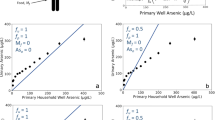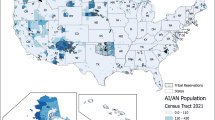Abstract
Although approximately 35 million people in the US obtain drinking water from domestic wells, few studies have investigated the risk of arsenic exposure from this source. In this paper arsenic concentrations were modeled for public and domestic wells using a dataset from the US Geological Survey (USGS). Excess lifetime and annual risks for lung and bladder cancer were calculated based on the carcinogenic potency and average arsenic concentrations in public and domestic water supplies. Monte Carlo uncertainty analysis was used to estimate the degree of confidence in these estimations. Results indicated that domestic well users accounted for 12% of the US population, but 23% of overall arsenic exposure from drinking water. Assuming that the new and more restrictive arsenic maximum contaminant limit (MCL) is implemented for public water supplies, it is anticipated that the proportion of people experiencing excess annual fatalities from drinking water from domestic wells will increase to 29% unless corresponding efforts are made to reduce exposures among domestic well users. Differences between public and domestic wells were not consistent across the nation. Public wells tend to tap deeper aquifers than domestic wells, and as a result local arsenic-depth trends can contribute to differences between public and domestic wells. Domestic wells and public wells in the western US have the highest arsenic levels with excess fatality risks estimated to be in the range of 1 per 9300 to 1 per 6600 in these regions. Uncertainty distributions of excess fatalities were developed and resultant uncertainties were propagated in arsenic exposure and potency factor. Uncertainty in the carcinogenic potency of arsenic was the dominant source of uncertainty in most regions, but for domestic wells in the New England and Southeast regions uncertainty in arsenic exposure was dominant, indicating that additional data on arsenic concentrations in these areas would substantially improve regional risk estimates.
This is a preview of subscription content, access via your institution
Access options
Subscribe to this journal
Receive 6 print issues and online access
$259.00 per year
only $43.17 per issue
Buy this article
- Purchase on Springer Link
- Instant access to full article PDF
Prices may be subject to local taxes which are calculated during checkout





Similar content being viewed by others
Notes
SPSS Inc., Chicago, Ill, U.S.A.
References
Ayotte J.D., Nielson M.G., Robinson Jr G.R., and Moore R.B. Relation of arsenic, iron, and manganese in ground water to aquifer type, bedrock litho geochemistry, and land use in the New England Coastal Basins. U.S. Geological Survey Water Resources Investigations Report 1999: 99: 4162.
Brown K.G., and Ross G.L. Arsenic, drinking water, and health: a position paper of the american council on science and health. Regulatory Toxicol Pharmacol 2002: 6: 162–174.
Chen H., Frey M.M., Clifford D., McNeill L.S., and Edwards M.A. Arsenic treatment considerations. J AWWA 1999: 91 (3): 74–85.
Ferguson J.F., and Gavis J. A review of the arsenic cycle in natural waters. Water Res 1972: 6: 1259–1274.
Focazio M.J., Tipton D., Shapiro S.D., and Geiger L.H. The chemical quality of self-supplied domestic well water in the United States. Ground Water Monit Remediation 2006: 26 (3): 92–104.
Focazio M.J., Welch A.H., Watkins S.A., Helsel D.R., and Horn M.A. A retrospective analysis on the occurrence of arsenic in ground-water resources of the United States and limitations in drinking-water-supply characterizations. U.S. Geological Survey Water-Resources Investigations Report 2000: 99: 4279. http://pubs.usgs.gov/wri/wri994279/
Frey M.M., and Edwards M.A. Surveying arsenic occurrence. J AWWA 1997: 89 (3): 105–117.
Gurian P.L., Lockwood J.R., Schervish M.J., and Small M.J. Addressing uncertainty and conflicting cost estimates in revising the arsenic MCL. Environ Sci Technol 2001b: 35 (22): 4414–4420.
Gurian P.L., and Small M.J. Point-of-use Treatment and the Revised Arsenic MCL. J AWWA 2002: 94 (3): 101–108.
Gurian P.L., Small M.J., Lockwood J.R., and Schervish M.J. Benefit-cost estimation for alternative drinking water maximum contaminant levels. Water Resour Res 2001a: 37 (8): 2213–2226.
Gurian P.L., Small M.J., Lockwood J.R., and Schervish M.J. Benefit-cost implications of multicontaminant drinking water standards. J AWWA 2004: 96 (3): 70–83.
Joel D.B., Stephjen C.P., Bjourn K., and Margaret R.K. Arsenic occurrence in New Hampshire Drinking Water. Environ Sci Technol 1999: 33: 1328–1333.
Johnston J., and DiNardo J. Econometric Methods. The McGraw-Hill Companies Inc., 1997.
Loiselle M.C., Marvinney R.G., and Smith A.E. Spatial distribution of arsenic in groundwater in maine; Geological Society of America, 2001 Annual Meeting; Boston, MA 2001; Geological Society of America: November 5–8, 2001.
Marquez E.B., Gurian P.L., Barud-Zubillaga A., and Goodell P. Geochemistry of groundwater arsenic in the El Paso region; Proceedings of the National Ground Water Association Naturally Occurring Contaminants Conference; Charleston, SC 2005.
McNeill L.S., and Edwards M.A. Soluble arsenic removal at water treatment plants. J AWWA 1995: 87 (4): 105–113.
Morales K.H., Ryan L., Kuo T.-L., Wu M.-M., and Chen C.-J. Risk of internal cancers from arsenic in drinking water. Environ Health Perspect 2000: 108 (7): 655–661.
Morgan M.G., and Henrion M. Uncertainty: A Guide to Dealing with Uncertainty in Quantitative Risk and Policy Analysis. Cambridge University Press, New York, NY, U.S.A. 1990.
NRC. Arsenic in Drinking Water. National Academy Press, Washington, D.C., U.S.A., 1999.
NRC. Arsenic in Drinking Water. National Academy Press. Washington, D.C., U.S.A. 2001 Update.
Ott W.R. Environmental Statistics and Data Analysis. CRC Press, Inc., Boca Raton, Fl., U.S.A. 1995.
Shaw W.D., Walker M., and Benson M. Treating and drinking well water in the presence of health risks from arsenic contamination: Results from a U.S. Hot spot. Risk Anal 2005: 25 (6): 1531–1543.
Shiber J.G. Arsenic in domestic well water and health in Central Appalachia USA. Water Air Soil Pollut 2005: 160: 327–341.
US Census Bureau. 2001. http://factfinder.census.gov/servlet/DatasetMainPageServlet?_program=DEC&_submenuId=datasets_1&_lang=en&_ts=
US EPA. Arsenic Occurrence in Public Drinking Water Supplies 2000: http://www.epa.gov/OGWDW/arsenic/pdfs/occurrence.pdf.
US EPA. Arsenic Rule Implementation, 2001a: http://www.epa.gov/safewater/ars/implement.html.
US EPA. 40 CFR Parts 9, 141, and 142; National Primary Drinking Water Regulations; Arsenic and Clarifications to Compliances and New Sources Contaminants Monitoring; Final Rule. Federal Register 2001b: 66 (14): 6976–7066.
Walker M., Shaw W.D., and Benson M. Arsenic consumption and health risk perceptions in a rural western U.S. area. J AWRA 2006: 42 (5): 1363–1370.
Acknowledgements
This research was supported by University Research Initiative of the University of Texas at El Paso. We thank Dr. Joan G Staniswalis and Dr. Charles D Turner for reviewing and commenting on the paper.
Author information
Authors and Affiliations
Corresponding author
Rights and permissions
About this article
Cite this article
Kumar, A., Adak, P., Gurian, P. et al. Arsenic exposure in US public and domestic drinking water supplies: A comparative risk assessment. J Expo Sci Environ Epidemiol 20, 245–254 (2010). https://doi.org/10.1038/jes.2009.24
Received:
Accepted:
Published:
Issue Date:
DOI: https://doi.org/10.1038/jes.2009.24
Keywords
This article is cited by
-
Toxic metal mixtures in private well water and increased risk for preterm birth in North Carolina
Environmental Health (2023)
-
A Community-Based Health Risk Assessment Following the Gold King Mine Spill: Results from the Gold King Mine Spill Diné Exposure Project
Exposure and Health (2023)
-
Estimation of health risks due to copper-based nanoagrochemicals
Environmental Science and Pollution Research (2022)
-
Seasonal Variation of Drinking Water Quality and Human Health Risk Assessment in Hancheng City of Guanzhong Plain, China
Exposure and Health (2020)
-
Arsenic redistributive accretion in interdune marshes and its impact on groundwater contamination of coastal plains (southern Brazil)
Environmental Earth Sciences (2019)



